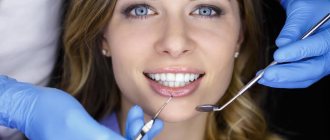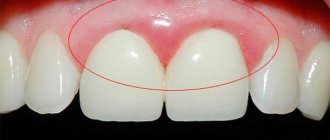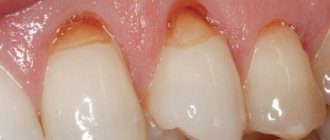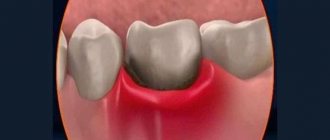Modern dentistry offers various methods to maintain healthy and crystal white teeth. But situations often arise when the only way to save a tooth is to remove the pulp. Although today it is very rare to use materials for canal filling that can change the shade of the enamel, after removal of the nerve, darkening of the tooth surface is observed over time due to its necrosis. Such modifications significantly spoil the smile and cause aesthetic discomfort.
Dentists at the Berezka clinic whiten a dead tooth and after the procedure it is completely no different from other units of the dentition.
Why does a dead tooth turn dark?
Teeth that lack nerves inside are considered dead. The surface of such processes is characterized by a tendency to change color and the appearance of dark spots. The reasons for the darkening of a pulpless tooth are as follows:
- lack of food. After the nerve is removed, the power to the tooth stops. Moisture leaves the enamel, nutrients are not supplied by the nerve endings, which leads to darkening;
- increased vulnerability. Without regular feeding, the tooth becomes very vulnerable. Pores form on the surface of the enamel, through which various coloring substances from the food consumed penetrate into the internal tissues. These dyes change the color of the enamel.
These are the most common reasons why tooth enamel darkens. In such cases, superficial bleaching of the dead tooth will help restore whiteness. But there are also often cases where a tooth has lost its original color due to bleeding during pulp removal. As a result, the enamel becomes reddish or purple. Classic whitening will not provide results in such situations; a more complex procedure will be required.
Removing the pulp of the affected tooth
Pulp removal is a complex dental procedure that requires a highly qualified doctor.
Stage 1 – local anesthesia or general anesthesia
At the first stage of treatment, local anesthesia is administered in the area of the affected tooth. In exceptional cases, the patient may require general anesthesia. The use of anesthetics allows one to avoid preliminary killing of the nerve with arsenic.
Stage 2 – x-ray
At the next stage, the doctor conducts an X-ray examination to determine the length of the root canals.
Stage 3 – pulp removal and tooth filling
All video presentations
After reviewing the x-rays, the dentist:
- gently removes pulp,
- cleans, rinses with antiseptic preparations and fills root canals,
- and then restores the natural anatomical shape of the tooth.
If all procedures are carried out competently, and the patient carefully and impeccably observes personal hygiene, then the service life of a pulpless tooth can reach several decades.
Severe toothache is a consequence of unprofessional dentists
Evidence that the dental operation was performed incorrectly is a sharp toothache accompanied by an increase in temperature. If depulpation is of poor quality, the patient may need repeated surgery. At the same time, aching, mild pain after removal of the dental nerve is considered normal.
Features of whitening at home
Home whitening of a dead tooth is a very convenient method, but in this case it very rarely provides the required effectiveness. This is explained by the fact that at home, as a rule, products are used that only have an external effect. Sometimes such methods are not enough to lighten the enamel and without introducing special components into the tooth cavity it is simply impossible to return it to its natural shade.
At home, whitening gels are usually used, which, after penetrating the enamel, activate chemical reactions in it. It is necessary to work with such substances with extreme caution, since there is a high risk of not only damaging the enamel structure, but also damaging the mucous membranes. Therefore, it is best to trust such procedures to specialists who can prevent possible risks.
Stages of intracanal bleaching
Endo-whitening is a method of lightening the crown of a tooth by filling the dental cavity with a whitening gel.
In-canal bleaching is performed in several stages:
- Preparatory. The doctor, first of all, must make sure that the cause of the darkening of the tooth was the removal of the nerve of the tooth, and not external factors. To do this, the doctor performs an examination of the oral cavity, and in some cases, preliminary whitening.
- Performing radiography. From the image, you can determine the condition of the root canals and fillings, as well as identify hidden inflammations.
- Anesthesia. Anesthesia is not a mandatory measure, since a pulpless tooth is not sensitive anyway. An anesthetic is used to eliminate the feeling of discomfort.
- Thorough cleaning of the tooth from plaque and pigment spots. Determining the true color of a tooth.
- Photo recording of a dental unit before treatment and during therapy in order to track color dynamics.
- If possible, the tooth is isolated from other units with a rubber dam.
- All old restorations, if any, are removed from the darkened tooth.
- Next, the doctor cleans the tooth cavity, removes all remnants of the filling material, pulp and parts of the root filling. This is necessary so that the whitening gel penetrates into the dentin.
- To seal the root filling, the doctor applies glass ionomer cement or flowable composite to the root canal orifices.
- A whitening agent is placed into the tooth cavity.
- A temporary filling is applied.
At the end of the procedure, the specialist will inform the patient about the date of the return visit. Whitening occurs gradually, so additional sessions will be required to replace the bleaching agent.
Once the desired result is achieved, a permanent filling made of composite material is placed on the tooth. In order to maximize the adhesion of the filling to the hard tissues of the tooth, filling is recommended to be carried out approximately 10 days after the last whitening.
One endobleaching procedure lasts about 30 minutes. In most cases, 3 sessions are enough to get rid of pigmentation. It is not recommended to carry out a fourth session in a row, as the periodontal tissues or dentin may be destroyed.
If after three procedures the tooth is still gray, you can undergo a second course of endodontic whitening after about 2 months.
Once the aesthetics of the tooth have been restored, x-rays should be taken once a year to rule out cervical resorption. Repeated intracanal bleaching can be performed after a year or more. It depends on how durable the result will be.
Dental treatment
Professional whitening of pulpless teeth
Whitening a dead tooth in a dental office is a completely safe and most effective procedure. One of the popular methods of professional lightening is endobleaching. The procedure is carried out in the following order:
- First, the dentist removes the old filling from the pulped tooth;
- then a special bleaching agent is introduced into its internal cavity. In most cases this is sodium perbonate, if necessary a small amount of hydrogen peroxide is added to it;
- After this, the doctor installs a temporary filling. If it is necessary to re-inject the brightening reagent, the filling is removed again. The number of procedures depends on the degree of darkening of the tooth;
- Once the desired color is achieved, a permanent filling is placed on the tooth.
In addition to intracanal bleaching, the dentist may also suggest other methods, for example, the use of veneers or crowns.
Clinical researches
Clinical experiments with the use of the Asepta series of products, conducted at the Ryazan State Medical University named after Academician I.P. Pavlova of the Ministry of Health and Social Development of the Russian Federation (GBOU VPO RyazSMU Ministry of Health and Social Development of Russia) have proven that the use of Asepta line products results in a decrease in complaints of discomfort, but bleeding persists when brushing teeth.
On examination, hyperemia and bleeding of the gingival papillae are noted. On the 7th day, complaints of gum bleeding persisted in 4 patients. Upon examination, a decrease in hyperemia and swelling of the gums was noted, but bleeding persisted upon probing. On day 14, 2 patients continued to complain of bleeding gums when brushing their teeth; upon examination, a significant decrease in hyperemia and swelling of the gums was noted. After the final application of the gel with propolis, normalization of clinical manifestations was revealed, which is manifested by the absence of bleeding during brushing and probing.
Sources:
- Clinical experience in using the Asepta series of products Fuchs Elena Ivanovna Assistant of the Department of Therapeutic and Pediatric Dentistry State Budgetary Educational Institution of Higher Professional Education Ryazan State Medical University named after Academician I.P. Pavlova of the Ministry of Health and Social Development of the Russian Federation (GBOU VPO RyazSMU Ministry of Health and Social Development of Russia)
- Report on determining/confirming the preventive properties of toothpaste “ASEPTA PLUS” GENTLE WHITENING” Author: doctor-researcher A.A. Leontyev, head Department of Preventive Dentistry, Doctor of Medical Sciences, Professor S.B. Ulitovsky First St. Petersburg State Medical University named after. acad. I.P. Pavlova, Department of Preventive Dentistry
- Clinical and laboratory assessment of the influence of domestic therapeutic and prophylactic toothpaste based on plant extracts on the condition of the oral cavity in patients with simple marginal gingivitis. Doctor of Medical Sciences, Professor Elovikova T.M.1, Candidate of Chemical Sciences, Associate Professor Ermishina E.Yu. 2, Doctor of Technical Sciences Associate Professor Belokonova N.A. 2 Department of Therapeutic Dentistry USMU1, Department of General Chemistry USMU2
- Report on the determination/confirmation of the preventive properties of personal oral hygiene products “ASEPTA PLUS” Remineralization doctor-researcher A.A. Leontyev, head Department of Preventive Dentistry, Doctor of Medical Sciences, Professor S.B. Ulitovsky First St. Petersburg State Medical University named after. acad. I.P. Pavlova, Department of Preventive Dentistry
Contraindications
It is necessary to refuse the intracanal bleaching procedure in the following cases:
- with increased tooth sensitivity;
- for dental diseases and inflammatory processes of the oral cavity;
- if the patient has caries or periodontitis;
- women during lactation should refrain from the procedure;
- Whitening is contraindicated for children and adolescents under 16 years of age.
Any of these factors can lead to undesirable consequences, so if at least one of them is present, you should think about the advisability of whitening and weigh all the possible risks.
Side effects of endobleaching
The fact is that any teeth whitening involves chemical destruction of protein dyes. When endobleaching, you have to deal with chemical dyes contained in filling materials. Therefore, initially there is a risk that the effectiveness of the procedure will be quite low. In addition, internal bleaching of a pulpless tooth seriously weakens its strength, since post-bleaching lesions in a non-vital tooth are not restored. Because of this, the risk of dental crown fracture increases significantly. Therefore, endobleaching cannot be performed more than four times.
Whitening prognosis and complications
Whitening a dead tooth is a fairly serious procedure that involves chemical action on tooth enamel. Therefore, before carrying out it, you should familiarize yourself with possible complications:
- the fragility of the result obtained, which necessitates repeated bleaching;
- The enamel of a dead tooth does not always acquire the same shade as healthy teeth. Even after lightening, the enamel can stand out from the rest;
- the enamel coating of a pulpless tooth after bleaching becomes even more fragile, in some patients it even begins to crumble and collapse;
- When applying the whitening component, the gums are irritated, so it should be done with extreme caution in patients prone to gingivitis, periodontitis and other pathologies.
Only a specialist can accurately determine whether intracanal bleaching is worthwhile or whether to look for safer alternative methods.
The Berezka dental clinic employs highly qualified specialists who can be trusted with complete confidence in tasks of any complexity and without worrying about unpleasant consequences.
Black teeth in children
The condition of “baby” teeth in children directly depends on the general condition of the body. Color changes can be caused by:
- Disorders of the gastrointestinal tract;
- Dysbacteriosis;
- Taking certain antibiotics;
- Decreased immunity;
- Fungus;
- Calcium deficiency;
- Excess fluoride and a number of other factors.
Just like permanent teeth, caries can develop in baby teeth. If a child’s tooth is black and hurts, then the destruction process has reached the internal tissues - the pulp.
Priestley's Raid
Parents often turn to the pediatric dentist with complaints about black plaque on the teeth that forms in the gum area. Despite its rather frightening appearance, this condition is usually not dangerous. Such deposits are called Priestley's plaque. The reason for black plaque on teeth is the development of the child’s digestive system, its adaptation to “adult” food. When the process is completed, the plaque disappears. But if you find black deposits on your child’s teeth, you still need to see a dentist. Often, caries develops under such plaque. You can stop this process at the initial stage using simple and painless methods.











